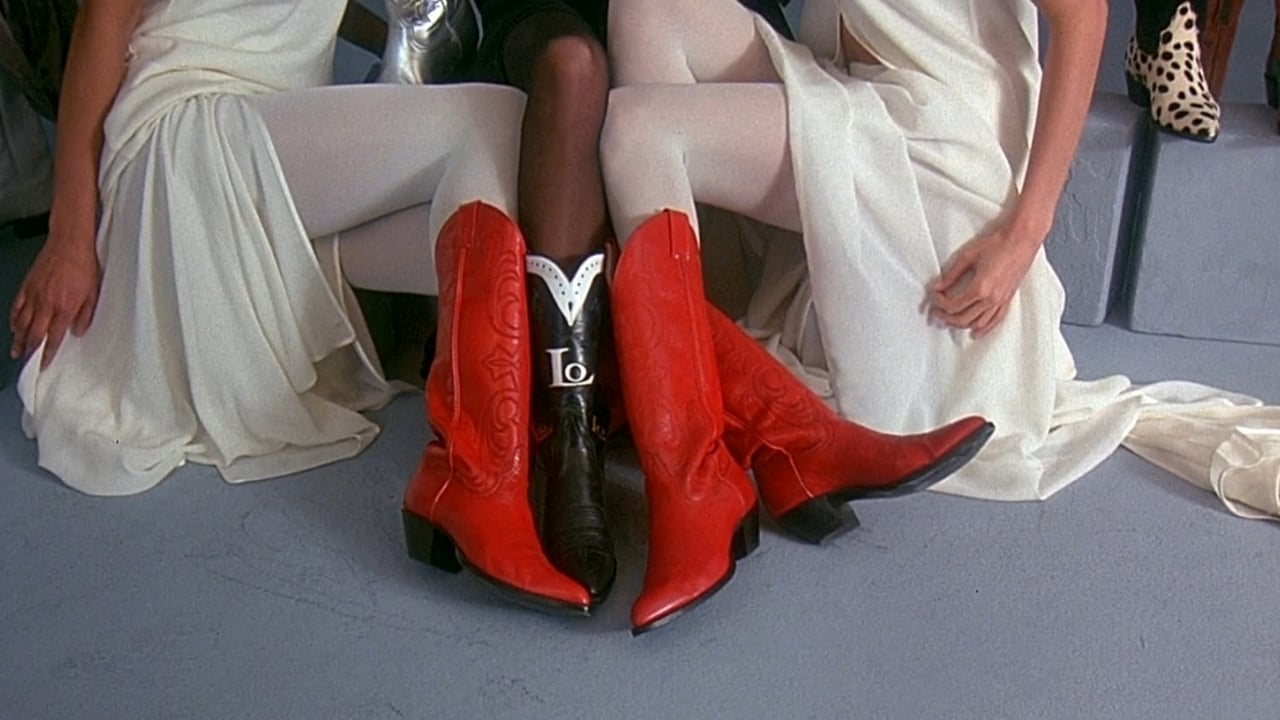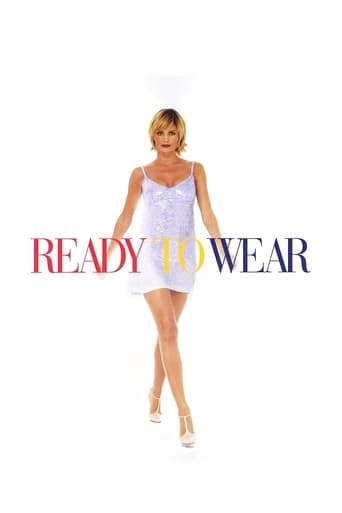

Undescribable Perfection
... View MoreSick Product of a Sick System
... View MoreA Disappointing Continuation
... View Morewhat a terribly boring film. I'm sorry but this is absolutely not deserving of best picture and will be forgotten quickly. Entertaining and engaging cinema? No. Nothing performances with flat faces and mistaking silence for subtlety.
... View MoreFashionistas and hangers-on and journalists from around the world converge on Paris during Fashion Week. By 1994, producer-director Robert Altman had acquired such a sterling reputation among actors (based on his free reign policy of letting his performers find their own way with their characters within the scenario) that the biggest stars of the time were willing to sign on to the latest Altman project, no matter the material. This may help to explain what Sophia Loren, Marcello Mastroianni, Julia Roberts, Tim Robbins, Lauren Bacall, Anouk Aimée, Kim Basinger, Rupert Everett, Linda Hunt, Forest Whitaker, Teri Garr, Tracey Ullman, Danny Aiello, Stephen Rea, Sally Kellerman, Lili Taylor and others are doing here, besides chatting-chatting-chatting themselves into a vacuum. Altman, who also co-wrote the screenplay with Barbara Shulgasser, appears to have even more contempt for runway fashion than he showed for country music in "Nashville", but at least there he had a solid group of characters courtesy of Joan Tewkesbury's acerbic script. Altman apes Tewkesbury's fragmented style in the hopes of capturing another irreverent gem, but neither the cast nor the fashions (nor all the overlapping talk) are interesting here. It's nice to see that Loren is still slapping Mastroianni but, without anything else to play, their scenes together merely feed on our movie memories without replenishing them. NO STARS from ****
... View MoreNo one can argue that Altman is a brilliant film-maker. But at least have the guts to say that this was not his finest hour.The film was a hodgepodge of scenes that was suppose to fit together nicely as we get to the ending as the models walk out on stage wearing nothing but lipstick. But in reality, this film was like watching clips from 'The Carol Burnett Show'. Some of the things in the movie are very well done. But the scenes did not fit together to make a coherent flow- as it seemed we drifted from situation to situation without a cause or purpose. Was not sure if this was suppose to be a comedy or a revelation of the fashion industry. Either way it was lost in the translation.This movie goes to prove, that even with a star-studded cast, you need a story that at least flows to reach a certain point for the audience to comprehend. This movie does not flow. In this collection of clips, there are some funny moments and some serious moments. While the moments are nice they cannot hid the fact the story was lacking.
... View More"I am Diogenes the Dog. I nuzzle the kind, bark at the greedy and bite scoundrels!" – DiogenesLike most of Robert Altman's films, "Pret-a-Porter" involves a large cast of characters gathering together to put on a performance, in this case a prestigious fashion show in Paris.The film was marketed as a satire, but it really isn't. This is fashion industry as scatology, a "world of sh*t" in which everything is grotesque and warped. As with Diane Arbus' famous photographs on "freaks", Altman deliberately blurs the boundaries between the "ideal" and the "abnormal", the "beautifully formed" and the "deformed", the "feces" and the "sanitary", the "inside" and the "outside".All the characters here are thus "freaks" in some way, all part of the same freakish human circus. There are dwarf attendants and magazine editors, transvestites, cross-dressers, lesbians, gays, the obese, the pregnant, adulterers, illegitimate babies, mortuary attendants, and a multitude of abrasive caricatures. Mixed in with these are the "ideal" bodies of the celebrities, the exposed unnatural/natural bodies of the models, identical twins who exchange their sexual partners, film-star parodies, television personalities and original film-stars reliving previous roles.Altman then contrasts modern sex icons (Basinger, Roberts etc), with ageing, disintegrating sex icons of the past (Sophia Loren, Lauren Bacall etc), and goes out of his way to tarnish "surface beauty" by imbuing the film's sex bombs with abrasive personalities.The much derided abrasiveness of the film is therefore intentional. Altman isn't just dealing with caricatures, he's dealing with the grotesque. Of course grotesque art is, by definition, "the least ideal form", always a war of "attraction and repulsion". As such, the reoccurring motifs here are dogs, animals and dog feces. More than juvenile poop jokes, Altman's recalling the scatological traditions of Diogenes, the dog philosopher.Diogenes was associated with public outbursts and obscenity. His ragged, unashamedly dirty existence radiated disrespect and contempt for all who gazed upon him. But while he was an animal, putrid and filthy, he was nevertheless "more civilised" than his "cultured" audience. In a similar fashion, everyone in this film is held under the contemptible gaze of Diogenes, whose mischievous dog feces show scorn for an intrusive and aggressive kind of, not so much modern culture (typified by television, celebrity, photography, fame and fashion – the usual boring targets of satire), but the hypocrisy of all culture.In the film, both television and photography are implicitly connected by characters accidentally stepping in dog feces. These accidents occur in both private and public places, playfully linking the home, studio and streets with a media culture which both intrudes on privacy (exposing shameful human behaviours, foibles and frailties) and disguises these behaviours by glitzing and glamming them up. So Altman is less concerned about the fashion industry, than about what garments and technology alternatively hide and expose, the prevalence of his symbolic doggy poop serving to bring the "high" down "low". Everything is grotesque whether you're on or off the catwalk.The film ends with a nude catwalk scene, one of Altman's most brilliant sequences. Here, models walk fully nude whilst the words "You're so beautiful the way you are" hum on the soundtrack. The sequence derides the commodification of "beauty", serves as an admittance that humanity is as grotesque as its ornaments/apparels, works as a dig at the fashion industry's obsession with "authenticity" (the true "inner subject/self", the "stripped down ego or essence"), and of course points toward the end result of all fashion-as-fetish-wear: total, naked sex. More than this, though, the sequence suggests that there is beauty in freakishness and freakishness in beauty, which is why a strange aura of both life and death radiates from this sequence. The catwalk models are like clones, cold stick figures, one of which is pregnant. The pregnant model speaks of a mystery about birth and something new, but she is also the least sexual of the models. Conversely, the others are like zombies, dead, crawling out of a tomb, yet are beautifully sexualised.This blurring, this confusion (ugliness in beauty, beauty in ugliness) is the very point of Grotesque art. Unlike the satirist, the grotesque artist does not analyse and instruct in terms of right and wrong or true and false (satire=logical, grotesque=irrational), nor does he attempt to distinguish between these. On the contrary, he is concerned about demonstrating their inseparability. Satire generally aims at three reactions from the audience - laughter, anger or disgust - but it aims to produce these separately. The grotesque, however, produces a reaction of confusion. With satire, there is an alternation or distinction between laughter and the gross evil which arouses anger. With the grotesque, however, laughter, hatred and anger seem to meld.Beyond this there are references to "Funny Face" and "Blow Up" (guess why), and Altman re-enacts a scene from De Sica's "Yesterday, Today and Tomorrow" with the same actors (Loren and Mastroianni). It's like the two lovers from De Sica's film (itself a film in which Loren and Mastroianni played multiple characters) stepped out of it and resumed their tale 40 years later in older bodies. Surprisingly, the same lead actors from Fellini's "La Dolce Vita" also appear, adding a dark tinge to Fellini's tale of those seeking "the good life".Tactics like this create a further effect. The characters lose weight, becoming flat, depth-less images. Consider when the real Elsa Klensch is interviewed by Kim Basinger who plays an Elsa Klensch character or when "real celebrities" like Cher and Harry Bellefonte briefly appear but yet still come across as empty, screen representations of themselves. The film paints a world obsessed with the "image", but stresses that there are few "authentic" images. The supermodels of the 90s were clones, destratified personae, simulations of imagined and imagined bodies, part of man's ritualised games of narcissism. By the films end, even a naked repudiation of this narcissism becomes a form of narcissism.7.5/10 – Two viewings required.
... View MoreI've seen it a couple of times. I understand Altman was maybe trying to create a disjointed, farcial almost surreal type atmosphere, but I found the lack of cohesiveness and clear cut thread annoying and it caused me to not care about the film or its characters. Being just a regular jane and not blessed with 15 or so credits in Film-making at NYU, the subtly of the art was lost on me. I desperately wanted just a little exposition to grab onto, and all the film's inside jokes and vague, obscure references to Italian films I found to be self indulgent. I'm not saying this film was bad - just bad for me. I think he could have pulled off the same feel and frenzied little European farce with a TOUCH more connective tissue in the plot. Not a lot, just a little for the audience to care about the story, the characters and whatnot. The thing I found in the film that I even cared more than a fig about was the Simone storyline.
... View More